Editors’ Introductory Note: This post first appeared in the excellent, long-running Rural Revolution blog. We recommend bookmarking it! We also recommend Patrice’s books.
o o o
Until a few days ago, October was a very dry month for us. Thankfully some much-needed and very welcome rain is moving in.
While it’s delightful to walk outside and sniff the fresh moist ground, we weren’t idle during the dry weeks. Among other chores, we focused a lot on firewood, a chief preoccupation for many people this time of year.
Summer before last, we had a neighbor come in with some huge equipment and clear out a lot of dead trees from the wooded side of our property.
He piled the burnable debris in big burn piles and put the salvageable logs in another pile just below our corral.
We’ve been harvesting firewood off that pile ever since. In the last few weeks, Don’s worked hard to cut it all into rounds.
When enough rounds are cut, we load them into a small trailer hitched to the tractor bucket, and bring them up into the driveway to split.
We’ve been repeating this process for several weeks now.
We’re stacking some of the split wood in the barn:
We’re stacking some on the side porch:
And we’re stacking some on the front porch:
We have room to stack lots more in all three locations, especially since we moved the kindling box from the front porch to the side porch…
…giving us more room on the front porch.
We always keep the hatchet in the kindling box for splitting kindling as needed.
A funny thing happened yesterday while Don was cutting rounds below the corral. He had on headphones and was listening to a recording of some Christmas choral music (he’s participating in a performance in a few weeks), and was singing the bass vocals at the top of his lungs. I was in the house so I couldn’t hear him — but suddenly I saw all seven cows gallop madly across the field and disappear behind the barn. Don came in chuckling a few minutes later and told me all seven animals had gathered in a circle around him as he sung, apparently fascinated by the music. “Let’s see if they’ll do it again,” I said as I grabbed the camera.
The animals weren’t quite as cooperative the second time round, but they were still pretty funny.
(I think this is known as “singing ’til the cows come home.”)
Even our neighbor’s cat stopped to listen to the impromptu recital.
At least, until the cows spotted the poor kitty and went barreling over to investigate.
This hearkens back to an earlier blog post about music soothing the savage beast, when I sang to Amy while she was nursing the orphaned calf Anna.
And speaking of Anna, here she is double-dipping off her full sister, Pixie, who’s also nursing her own calf Peggy. (Anna is the dark calf, Peggy is the dun calf mostly hidden behind Pixie.)
Despite the crushing loss of Polly earlier in the year, Anna has fended very well for herself, thanks to the generosity of other cows sharing their milk.
We had more rain due yesterday evening, so I decided to clean the chicken coop, a long-overdue task.
The cows watched me with great interest as I dumped the debris into the compost pile.
By the time I finished spreading fresh hay in the coop, it was dusky…
…and the sky was getting thicker as clouds moved in.
It was pleasant to lie in bed last night, listening to the rain on the roof and knowing the chickens had a comfortable cozy coop.
We have one recuperating bird in the coop. A week ago around 9 pm, I heard a commotion outside. I grabbed a flashlight and went out to find a great horned owl standing on the carcass of one of our young hens (from this summer’s hatching). I chased off the owl and picked up the bleeding hen, and tucked her inside an inner pen in the coop to either live or die.
By the light of the flashlight, here’s some of the blood from the hen…
…as well as some lost feathers.
This little hen, along with some other birds, roosts in an overflow pen adjacent to the coop. The door to this pen isn’t solid, so once in a while an owl will swoop in over the top of the door and drag out a chicken. Hooking a sheet over the door each evening works (if the owls can’t see the chickens, they don’t go in). I just hadn’t started hooking the sheets up yet this fall. You can bet I am now.
Anyway, the young hen survived her encounter with the owl, and while she’s now on her feet, she’s wobbly. She might be fighting a leg fracture, I’m not sure. We’ll keep her quiet and isolated in the pen for a couple more weeks and see how she does.
Anyway, that’s some of what we’ve been up to lately as winter approaches.
Note: This post first appeared in the excellent, long-running Rural Revolution blog. In her blog, Patrice Lewis focuses on homesteading and self-sufficiency. The Lewis family lives in the American Redoubt. Their lifestyle typifies conservative self-sufficient families in Redoubt.

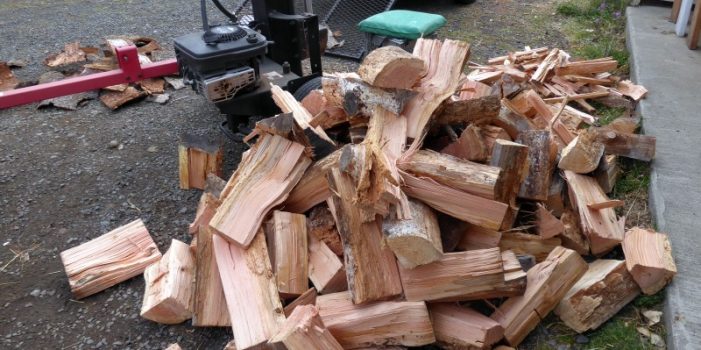









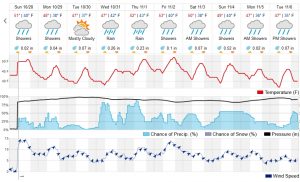
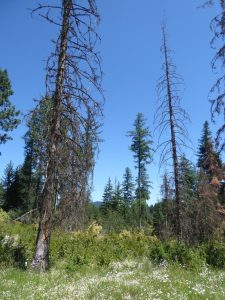
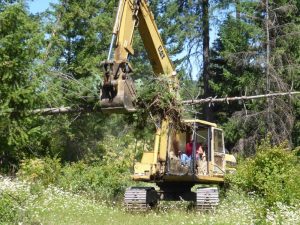
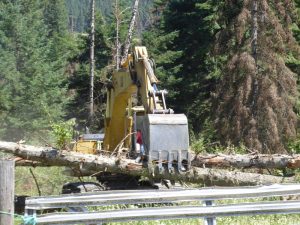
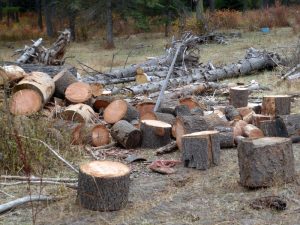
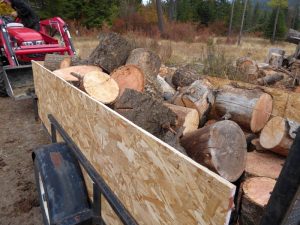
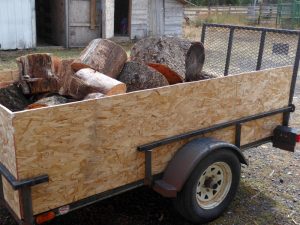
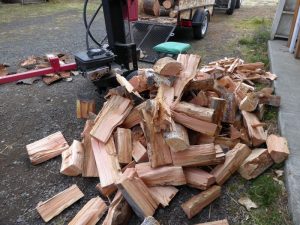
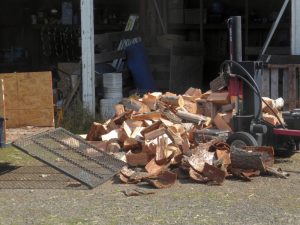
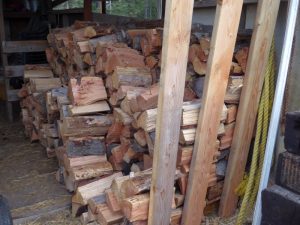
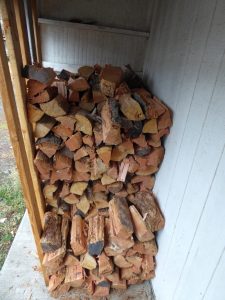
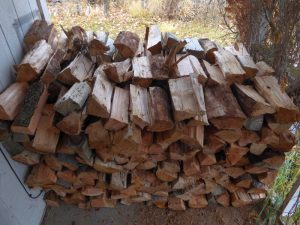
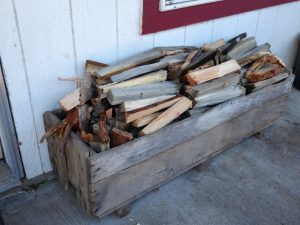
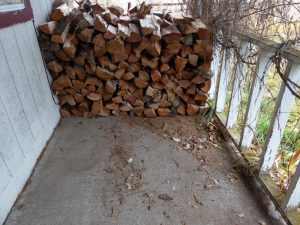
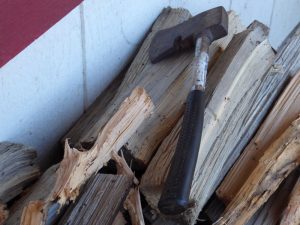
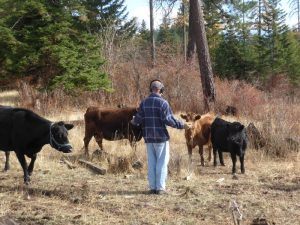
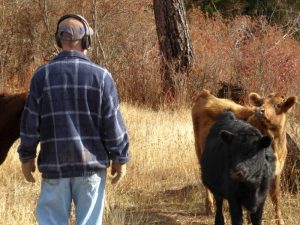
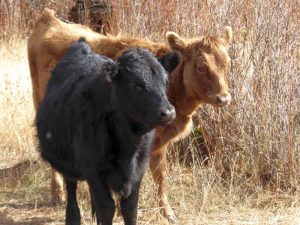
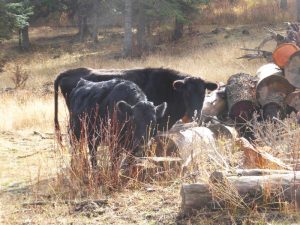
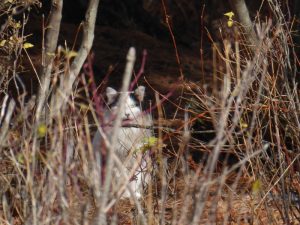
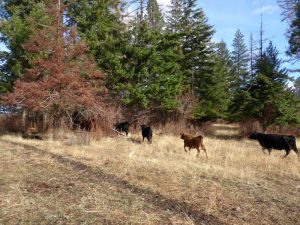
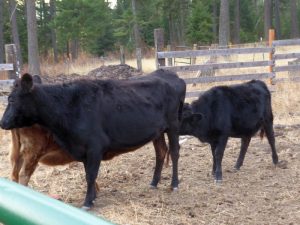
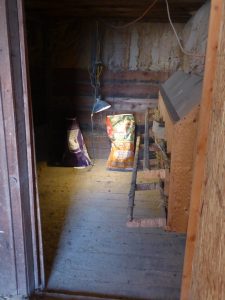
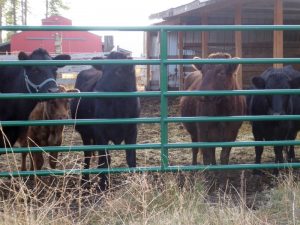
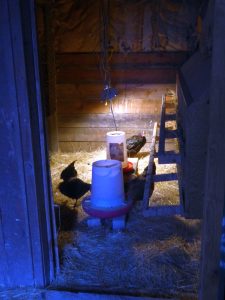

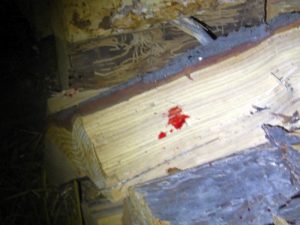
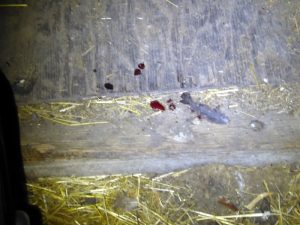
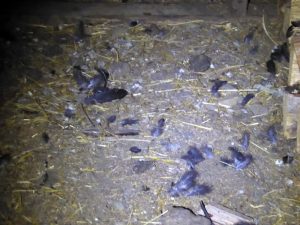

Half a country away we have cows that look just like yours!
One thing we’ve found with wood processing is to try to cut down the handling as much as possible. There are times when we move the cut rounds back to the house then to be unloaded, then to be split, then to be stacked….. But when we can, we move the log splitter to the rounds, split them and pitch the cuts directly into the truck. The truck is then backed right up to the sheds and the wood stacked. Cuts out one handling of the wood which ends up saving time over a quantity of wood.
Your excavator can be used to hold a long log up off the ground a bit while you cut the rounds, saving a lot of bending over and potentially putting the rounds right where you need them to be when split. We do that with our excavator but you can do it also with a bulldozer or a backhoe depending on size of tree.
We are down south and harvest a lot of firewood, usually keeping at least 3-4 years worth under sheds in various states of drying. I can’t imagine how much wood you folks north of the Mason-Dixon line have to process every year to heat solely with wood.
Thanks kindly for your post.
I particularly enjoyed y’all’s creativity in packing away loads of insurance (firewood!). We been putting away a lot more than we have in the past as we see many Storm Clouds on the horizon.
I hope and pray Almighty God that you and your loved ones fare well in the months ahead sir.
Respectfully,
Billy
Chief Petty Officer, U.S. Naval Special Warfare (Retired)
“SALVATION IS OF THE LORD.” -Jonah 2:9c [KJV]
Web-log: http://thehoffmannreport.blogspot.com/
Enjoyed the pictures. Just curious, are termites not a concern in that area? I could never stack wood directly against my house here in the South. At least that’s what I’ve always been warned about. I knew one home owner that did and he wound up rebuilding his whole porch and part of the front wall of his house from termite damage.
Having 5 or 6 cords of stacked wood gives a comfortable feeling. We are in the mid-south and cannot stack wood on porches due to termites. We stack ours about 15 yards away and then move small daily amounts under the carport during bad weather so we don’t have to get wet/cold bringing in wood.
We fenced our chicken free range area and have a top and lower hot wire around fencing which keeps the owls, hawks, raccoons, opossums, etc., from waiting for a chicken dinner. So far it has fried 3 owls, a young hawk and a juvenile coon. The smaller chickens have a smaller free range area and it is topped with plastic netting to keep the predator birds out.
Hey there Animal House and JL. We’re blessed here in our area of the Redoubt with a truly wonderful lack of termites. We’re also pretty shy of fleas and ticks. Having grown up in areas with all three of these pests, living here is a very pleasant change. My personal nemesis regarding home destruction is the yellow-shafted flicker, a type of wood pecker who loves to blast huge holes in the house siding. For this reason, the .22 air rifle was created.
Animal House – We usually go through about 6 cords a year, mostly red fir and tamarack (western larch for us AR types). As far as increasing security for the chickens go, I’m finally going to build a large chicken yard with a chicken wire top. We’ll put our annual feed lot scrapings in there so that the chickens can scratch, but despite the benefits that total free-range can bring, having to hunt up the latest laying spot in acres of trees is wearing Patrice and I out.
sooooo……..did the hen survive??????
So far, so good.
You are just asking for trouble by staking that wood next to your house. Bugs will eat, not only the wood, but your house too. Also mice/rats will hide in it. That’s why, back in the day, they had something called a “Wood Shed”.
Tex, I was taken to the wood shed numerous times as a young-un, even though we didn’t heat with wood.
Hi Texas Scout. See my reply to Animal House above. But in short, we don’t have the same types of critters you have.
No wood ants? No Rats?, No mice? I want to move there!
Here in southern Idaho we have mice — big fat mice. And I’m fairly sure we get them from the woodpile in the neighbor’s yard. My cat is quite good about keeping “her” yard vermin free — and makes sure she brings them into the house to show us what a good mouser she is.
A cat with a prepper mentality who I am sure could survive without her canned or bagged food if needed. That’s Idaho for you.
It reminds me of my Dad’s place in Tennessee. Unfortunately my dad has given up on his animal husbandry. He sold his cows due to dogs harassing and killing some calves along with his age and health issues. His cats and dogs have all passed, again trouble with neighboring dogs running in packs. He also had a hard time with predators, mainly raccoons, killing off all his chickens. The only thing he has left are my cousin’s horses that live and pasture on his fields and property.
As for your neck of the woods, it is a lot different than the southeast where I hail from. I live right in a transition zone between costal plane and piedmont. To the north in the piedmont we have clay soil, rolling hills covered in Loblolly or longleaf pines and beautiful hardwood bottoms. In the coastal plane the hills are a softer rolling and the soil in mainly sand, formerly ocean front property. We have to deal with sand gnats that to me are almost unbearable in the summer. What I find completely foreign about your area is how the trees, being similar to our pines, can be cut and left on the ground. Here a soft wood pine tree on the ground will pretty much be gone in a year or two. Several things act on the decomposition of a pine tree left on the ground. We have termites, fire ants, wood ants, beetle grubs, animals digging and tearing at the tree for the grubs, but the biggest factor is a fungus that rots the wood quickly. Anyway, it just amazes me how your wood keeps so well in the redoubt.
If you have a box blade for your tractor you can weld a 1 7/8 inch ball or a 2 inch ball (whichever is compatible with your wood trailer) to the back top of your box blade and pull your trailer behind your tractor as you drive forward instead of operating from your bucket. That may be better. And you’re lucky to be living up north and not have the snake problem I have here in the south. If I stack firewood anywhere it attracts mice which then attracts copperhead and rattle snakes. I enjoyed your article.
I live in NW Montana and have been sawing 7-8 cords a year for 20 + years. Other than a ceramic heater that I keep in my bathroom, wood is the only source of heat I have. Being a tad macho I had always split the bigger rounds with a maul and wedge. If I hadn’t of had that slight streak of pride I might have invested in a splitter a long time ago. But I’ve also been kind of a cheapskate and didn’t want to put out the bucks on one. That is until I saw what my neighbor brought home. He showed me what an electric splitter that he had bought at Home Depot could do. It is every bit as fast as any gas powered splitter that I have seen. And the price is about a third. If a guy were to rig up an inverter and maybe an extra battery under the hood of his truck rounds could be split on the tailgate.
Oh, and let me tell you what I started doing with the really big rounds instead of lifting them into my pickup bed. I built a ramp and now roll them in. I guess I’m getting to be a wuss in my old age.
Just out of curiosity, what kind of splitter do you have? I’m in the market and am trying to make sure I get a good one.
I use a Homelite. It splits even the biggest rounds.
Scott71..I have a “dirty hand tools” brand splitter, it will split a 24″dia. white oak log without any trouble. It is heavier than most splitters of the same tonnage, and it is built in Colorado.
My wood shed holds 8 cords. I cut enough to refill it every other year. It is warm enough where I live that we don’t need many fires. I have a “quick attach” bracket for the front end loader on my tractor. I purchased “quick attach” fork lift forks that fit my tractor. I cut my logs into lengths that I can handle with my tractor due to weight or length. I move these whole logs to within 10 feet of my wood shed. I then cut them to length. Then I roll them a few feet to my three point hitch mounted wood splitter that is powered by my tractor hydraulics. I built a movable bracket that is attached to the hydraulic ram plate that pushes the block thru the splitting wedge. When the block is split, the two halves stay on this bracket as the ram retracts so they don’t have to be moved back and lifted on to the splitter again. Then each half can be turned and re-split as needed. The finished piece of wood is then pitched into a pile at the open end of the wood shed. When I get tired, I call for the stackers (three adult women), who stack and sort the pieces as they prefer while I rest. In my region, we burn exclusively red oak and various kinds of pin oak. Our trees easily grow up to 4 feet in diameter and 80 feet tall. I have cut branches that were 18 inches in diameter and 20 feet long. A 24 inch diameter “round” that is 18 inches long can weigh 400 pounds if it is green. My splitter sits on the ground when operating with the bracket sitting about 8 inches off the ground and operating horizontally. I have a short stool that I sit on to save my back. I made my splitting wedge about 24 inches long so I can split huge logs up to 30 inches in diameter.
Once I get the limbs cut from these trees and all the small branches are cut from the main limb, I gather them up and move them within 5 feet of my wood shed with my forks and make a pile about 5 foot high. Then I take my small chain saw and cut them to length for stacking. They are handled only once.
The largest diameter oak log that I saw cut for firewood was 5 feet in diameter. the red oak blocks were 5 foot diameter and cut 18 inches long. My neighbor had called for help to turn them from the “round” side up to the “flat” side up so he could split them with a sledge hammer and wedges to make them small enough so he could use his splitter. It took three grown men to “rock” the blocks back and forth enough that they would fall over. When they hit the dirt, they made a 4 inch indention in the dirt.
Most of the wood I cut is 18 to 24 inches in diameter. No I’m not Paul Bunyan.
Very fun article to read. I could smell the split wood looking at the pics. Last night, I attended my third workshop on wildfire, each presented by a different fire fighter. All of them were adamant about not stacking firewood near the house or under/on porches. Firebrands travel up to a half-mile ahead of a crown fire and firewood is readily ignited. My solution for firewood is a high-cube shipping container. I stack it over 8 feet high leaving just enough room for the lights. I can get about 13 or 14 cords in there, but so far have only loaded about 8, the rest of the space is jammed with spare solar panels and other gear.
Inside the container, I have no issues with critters, wildfire, rain, and the heat inside with the doors closed (summer time) bakes the moisture out of the wood faster.
I’m always impressed with the lifestyle of homesteaders and love the articles they share with us.
Containers also serve well as generator sheds, work shops, even guest houses. My main reason for using them is their fire resistance, assuming defensible space is maintained around them.
We’re now considering welding two of them together and knocking the inside walls out for a 16′ x 40′ shop.